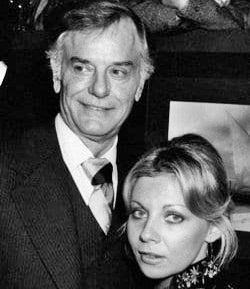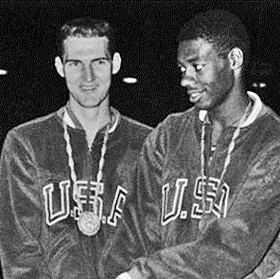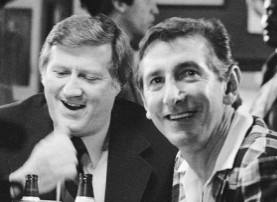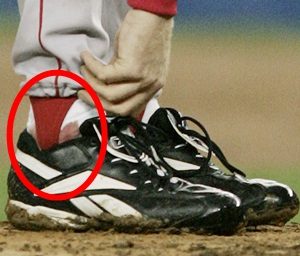10/19 Entertainment History
“Being a father to my family and a husband is to me much more important than what I did in the business. But my wife says that my tombstone will read, ‘Here lies Mr. C, who used to be Mr. B.’ I think that’s probably what I’ll be remembered for.”
~Tom Bosley
ROCK & ROLL HISTORY
1958 – 13-year old Brenda Lee recorded Rockin’ Around The Christmas Tree at the Bradley Film & Recording Studio in Nashville.
Although Decca released the single in both 1958 and again in 1959, it did not sell well until Lee became a popular star in 1960. It has since turned into a perennial holiday favorite.
1967 – Smokey Robinson & The Miracles released I Second That Emotion. The single peaked at #4 in the U.S. and #27 in England.
1979 – Tom Petty & The Heartbreakers released the Damn The Torpedoes album.
It was a breakthrough for Petty and the Heartbreakers, rising to #2 on the Billboard Albums chart, and yielded two songs that made the top 15 on the Billboard Hot 100 singles chart; Don’t Do Me Like That (#10) and Refugee (#15).
1981 – Lindsey Buckingham released Trouble. The single peaked at #9 on the Billboard Hot 100.
2014 – Raphael Ravenscroft, forever famous for his sax solo on Gerry Rafferty’s Baker Street, the most recognizable sax riff in pop music history, died of a heart attack at the age of 60.
MOVIE/TV HISTORY
1953 – After popular singer and heartthrob Julius La Rosa finished his version of Manhattan on the CBS radio broadcast of Arthur Godfrey Time, Godfrey fired the young singer on the air.
Godfrey later claimed LaRosa had lost his “humility,” but several historians claim that Godfrey was actually upset that the singer was beginning to receive more fan mail than the host.

1978 – Actor Gig Young died in a murder-suicide three weeks after his marriage to magazine editor Kim Schmidt.
Police theorized that Young shot his wife – she was his fifth – and then turned the gun on himself. A motive was never found although it was well established that Young had been battling alcoholism for over 25 years. He was 64
He starred in The Desperate Hours, Teacher’s Pet, Come Fill The Cup, and won the Academy Award for Best Supporting Actor for his performance in They Shoot Horses, Don’t They?
1990 – Dances With Wolves premiered at the Uptown Theater in Washington, DC.
The film starred Kevin Costner (who also directed), Mary McDonnell and Graham Greene.
Despite its high production costs ($22 million), the film was a massive box office hit, grossing $424.2 million worldwide.
Dances With Wolves was nominated for twelve Academy Awards and won seven; Best Picture, Best Director, Best Adapted Screenplay, Best Film Editing, Best Cinematography, Best Original Score, and Best Sound Mixing.
1994 – Actress/singer Martha Raye (The Big Broadcast of 1937, Rhythm On The Range, Hellzapoppin’) died of pneumonia after a long battle with Alzheimer’s disease. She was 78.
But she was a lot more than a Hollywood celebrity.
In appreciation of her work with the USO during World War II and subsequent wars, she was buried with full military honors in the Special Forces Cemetery at Ft. Bragg, NC as an honorary colonel in the U.S. Marines and an honorary lieutenant colonel in the U.S. Army.
She is the only civilian buried at that location who receives military honors each Veterans’ Day.
2009 – Actor Joseph Wiseman died of natural causes at the age of 91.
He starred in Viva Zapata! and Detective Story, but was best known for his role of the title character in Dr. No, the first James Bond film.
2010 – Actor Tom Bosley died at the age of 83. He had been battling lung cancer and died of heart failure.
His first big break came when he was cast as larger-than-life New York City Mayor Fiorello LaGuardia in the Broadway musical Fiorello!, a performance that earned the 1960 Best Featured Actor Tony Award
On television, he starred in Murder, She Wrote and Father Dowling Mysteries, but will always be remembered for portraying Howard “Mr. C” Cunningham on Happy Days.
SPORTS HISTORY

1960 – After spending the summer as teammates on the 1960 U.S. Olympic Gold Medal basketball team, Jerry West made his professional debut with the Los Angeles Lakers while Oscar Robertson debuted with the Cincinnati Royals.

1987 – George Steinbrenner did it again! He hired Billy Martin (for the fifth time!) as manager of the New York Yankees.
Billy didn’t make it halfway through the next season before he was fired again.

2004 – The Boston Red Sox tied the American League Championship Series at three games each with a 4-2 win over the New York Yankees.
The game will be remembered as Curt Schilling’s “bloody sock” game.
Schilling pitched with a torn tendon sheath in his right ankle, which was sutured in place in an unprecedented procedure by Red Sox team doctors.
To help stabilize the tendon in his ankle, Red Sox doctors had placed sutures connecting the skin with ligament and deep connective tissue next to the bone, effectively creating a wall of tissue to keep the peroneal tendon from disrupting Schilling’s pitching mechanics.
In 2014, Schilling was still being accused of faking the injury and using ketchup to add “proof” of it. He tweeted this photo and added “Found this in an old folder, for all you ketchup dinks.”

Compiled by Ray Lemire ©2005-2020 RayLemire.com / Streamingoldies.com. All Rights Reserved.
